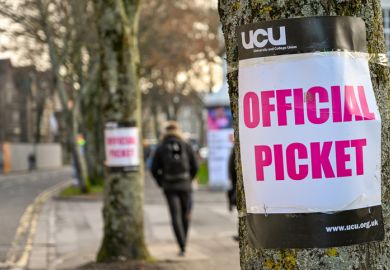Higher education has long been known to have a gender pay gap but the sector’s performance in the UK government’s nationwide data collection exercise is nonetheless shocking.
Every university that submitted its data ahead of the 4 April deadline reported that men’s mean pay was higher than women’s, with four out of five institutions revealing a gap reaching double figures. Thirty institutions reported mean average pay gaps in excess of 20 per cent per hour.
Analysis of the data by Times Higher Education shows that women in UK universities are paid a mean hourly rate that is, on average, 15.9 per cent lower than men’s. The median average gap, which tends to reduce the effect of outliers, was 16.5 per cent.
The data indicate that women fare worse in higher education than in other sectors, with the median pay gap among employers that submitted their data standing at 9.7 per cent.
Many of the institutions with the largest gaps reported their data in the final weeks before the deadline. The largest pay gap was found at London Business School, where women’s mean hourly salary was 45 per cent lower than men’s. This perhaps reflects the industry that the institution prepares its students for and, hence, where it draws its staff from; the finance sector was found to have one of the largest gender pay gaps, and last month HSBC revealed one of the highest reported gaps to date at 60 per cent.
The second-largest gap, a mean average of 30 per cent, was found at the Royal Veterinary College, while Lancaster University and Harper Adams University share third place on 27.7 per cent.
Noticeably, all these institutions employ a higher proportion of men than women in the highest-paid roles. At LBS, for example, 58.5 per cent of employees in the top salary quartile are men; although the gap is largest at Cranfield University, where 77.6 per cent of highly paid positions are held by men.
More broadly, institutions with medical schools, which may have highly paid clinical staff on their payrolls, or those that are more research-intensive and are therefore more likely to have larger professoriates – an area of the higher education workforce known for its gender imbalance – tend to report larger pay gaps.
For example, of the 30 institutions reporting the largest mean pay gaps, 13 are members of the Russell Group of large, research-intensive institutions. Among the 22 members of the mission group that submitted their data, the mean pay gap was 21.2 per cent, while the median was 16.7 per cent.
Institutions that reported the smallest average pay gaps tend to have a much better gender balance on their top teams. Universities with more women than men among their top roles still reported overall gender pay gaps, however. For example, nearly two-thirds of employees in the top salary quartile at the University of Worcester are women, but the university still reported a mean pay gap of 3.2 per cent – albeit the lowest figure reported by a UK higher education institution.
Meanwhile, at every UK university that provided data, women dominated the lowest salary quartile, traditionally representing the most poorly paid jobs such as cleaning and administration.
Lancaster said that its figures reflected a higher concentration of female staff in the lower grades “for both professional services staff and for academic, research and teaching staff”. A spokesman said that the university employed more than 200 staff in grade 1 part-time positions, 85 per cent of whom are female.
Higher up the pay scale, Lancaster has 300 professors, less than a quarter of whom are female – something that could in part be attributed to a low turnover of staff. “There are 23 per cent females at senior staff grades, but there are only 27 of these roles,” the spokesman said.
Nevertheless, the size of the pay gaps – and their existence in institutions with a high proportion of women in highly paid roles – indicates that the problems cannot be blamed on long-standing gender divides in the workforce alone.
Danny Dorling, Halford Mackinder professor of geography at the University of Oxford, said that the “excuses” being given by employers were “amazingly bland” and “none will stand up in a year’s time”.
“Almost invariably the gaps are widest among the highest paid,” he said. “Male and female cleaners tend to be paid similar amounts to each other, but not male and female managers, bankers or aeroplane pilots.”
Meanwhile, the fact that the majority of cleaning roles are held by women cannot explain why universities perform worse than other sectors, given that this is a nationwide phenomenon.
Professor Dorling suggested that, in the university sector, “what will most likely reduce the gap will be an election of a Labour government and the end of the £9,000-plus-a-year fees bonanza”.
“That bonanza led to an extra billion pounds in the sector after 2012...running a university sector on debt is part of what allows a small number of men to become so highly paid,” he said. “I suspect the gap is less in countries with lower student fees.”
The government hopes that, by shining a light on gender inequality, firms will be spurred into taking action to address the problem. There is some evidence that this is already happening, even at LBS, which reported the biggest gap.
A spokesman for the institution said that, while its numbers “still do not reflect where we want to be”, the institution has increased the proportion of applications from female faculty shortlisted for interview for tenure-track positions since the reporting requirement was introduced. It has also created a “family-friendly task force” to support early to mid-career faculty, as well as a bespoke programme aimed at senior women in banking.
Employees will no doubt be keeping an eye on how universities respond and watching closely for complacency.
Marianna Dudley, lecturer in environmental humanities at the University of Bristol, said that she had been disappointed to hear the institution respond to what it called the “good news” that Bristol’s 16.2 per cent median pay gap was below the national average.
“I’d like Bristol to take real leadership on this issue by making progressive policies that actively address the gender pay gap,” Dr Dudley told THE. “Tackling issues of progression, for example, that demand a full recognition of the barriers that women face, and crucially, offer real solutions.
“At the current rate of change, it will take several decades to close the gap. That is not good enough.”
On a sector-wide basis, Advance HE, formed by the recent merger of the Equality Challenge Unit, the Higher Education Academy and the Leadership Foundation for Higher Education, said that it planned to undertake further research to understand how institutions were planning to tackle their pay gaps.
“Pay gaps are an important symptom of systemic equality, but the sector must look closer: at culture, at recruitment, progression and leadership to truly understand and challenge the cause,” said Ellen Pugh, a policy programme manager at the organisation.
A spokesman for the University and College Employers' Association said it was "not helpful" to describe pay gaps as a sign of women earning less than men, "as we know that HE institutions use job evaluation to ensure equal pay for work of equal value and regularly undertake equal pay reviews to identify and remedy any such issues".
"Earlier analysis of data from the Office for National Statistics on the gender pay gap in HE has shown the marked narrowing of the gap. The downward trajectory, a reflection of HE institutions’ achievements thus far in addressing their gender pay gaps, is often overlooked.
"All HE institutions have been supportive of Ucea’s past and ongoing joint work with the sector trade unions to develop a better understanding of practice and trends relating to gender pay gap issues, to explain the differences between equal pay auditing and gender pay gap action planning and to explore effective interventions.
"There is of course more work to be done to continue addressing the multiple causes and find solutions to ensure that women can progress their careers and move into senior levels in their workplaces.”
rachael.pells@timeshighereducation.com
Elsevier reports biggest gender pay gap among publishers
Academic publishers have revealed significant gender pay gaps, most notably Elsevier.
The company, which employs about 1,200 people in the UK, reported a mean average pay gap of 29.1 per cent and a median gap of 40.4 per cent.
RELX, Elsevier’s parent company, has committed to having a global workforce that is 51 per cent female and 49 per cent male. But Elsevier said that a lack of women in senior roles was to blame for its figures.
“Many factors contribute to this. For example, Elsevier recruits a lot of employees from STEM [science, technology, engineering and mathematics] industries, which attract more men than women,” the company stated.
Taylor & Francis, which revealed the second-highest gap at 24.2 per cent, has a similarly high ratio of men to women in senior jobs despite the overall workforce being two-thirds women.
The majority of publishing houses were notable for paying much larger bonuses to men than women. The gender gap in the value of bonuses at Wiley, for example, stood at 42.3 per cent. At Taylor & Francis, the gap was 57.6 per cent in the year leading up to April 2017.
| Publisher | Mean average | Median average |
| Elsevier | 29.1 | 40.4 |
| Taylor & Francis | 24.2 | 8 |
| Oxford University Press | 24.1 | 12.6 |
| Cambridge University Press | 24 | 19 |
| Sage | 22 | 14.5 |
| Wiley | 21.1 | 21.5 |
| Pearson | 21 | 15 |
| Emerald | 20 | 24 |
| Springer Nature | 17.6 | 15.2 |
Wide variety in research council performance on gender pay gap
The gender pay gap among the UK’s research councils has been shown to vary widely, with Innovate UK reporting by far the largest divide.
The agency said that women were paid 26 per cent less than men per hour, according to the mean average, while the median gap was 36 per cent.
Women hold just 29 per cent of top-paid jobs at the organisation and their average bonuses for the year leading up to April 2017 were 30 per cent lower than those of their male colleagues.
At the other end of the scale, the Economic and Social Research Council reported a mean average pay gap of 2.6 per cent – thought to be the lowest across higher education and research – and a median pay gap of zero.
There are significantly more women across all levels of the workforce and 59 per cent of women received bonus pay, compared with 49 per cent of men.
Sir Mark Walport, chief executive of umbrella body UK Research and Innovation, said that the figures demonstrated that “there is a job to be done to identify and share effective practice in equality, diversity and inclusion” across all research councils.
| Average pay gap per hour | ||
| Research council | Mean | Median |
| Innovate UK | 26 | 36 |
| MRC | 15.5 | 5.5 |
| NERC | 15.1 | 11.8 |
| BBSRC | 14.8 | 10.4 |
| Hefce | 14.4 | 19.9 |
| EPSRC | 11 | 0.4 |
| AHRC | 10 | 0.4 |
| ESRC | 2.6 | 0 |
POSTSCRIPT:
Print headline: Gender pay gap: how does your campus compare?
Register to continue
Why register?
- Registration is free and only takes a moment
- Once registered, you can read 3 articles a month
- Sign up for our newsletter
Subscribe
Or subscribe for unlimited access to:
- Unlimited access to news, views, insights & reviews
- Digital editions
- Digital access to THE’s university and college rankings analysis
Already registered or a current subscriber?







